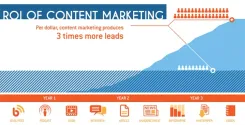Related Posts
Financial Institutions
Using Financial Wellness for Content Marketing
Last Update: May 4, 2020
Content marketing is nothing new.
In fact, it began in the late 19th century when John Deere began writing The Furrow magazine that not only advertised its own products, but also provided advice, information and enjoyable content for farmers.
However, it wasn’t until the age of the Internet that content marketing exploded with the advent of blogs and social media platforms.
Content marketing is a valuable way to reach consumers, as can be seen by the enormous use of the strategy:
- 70 percent of companies have a content marketing strategy1
- 72 percent of marketers agree that content marketing is a key to their success2
- Content marketing will grow by $269.24 billion between 2020-20243
When a financial institution provides useful content to consumers that explains how their products and services solve their challenges, you can gain customers, improve brand awareness, and boost your bottom line.
What is Content Marketing?
For financial institutions to use content marketing correctly, it is important to understand what content marketing is—and what it is not.
Content marketing is more than adding articles to an online library.
Instead, it is a campaign that creates and distributes content in a way that reaches your target audience.
Effective content marketing campaigns:
- Educate consumers about your products and services
- Build relationships
- Show how your products and services solve their problems
- Create a sense of community
Types of Content Marketing
The types of content marketing are nearly limitless, but here are some of the most popular ones used today.
- Social Media: 3.8 billion people use social media platforms such as Twitter, Instagram, Facebook, Pinterest, LinkedIn, and more. This provides financial institutions with a variety of ways to connect with their target audience.4
- Infographics: An easy way to distill a topic down to its core message, an infographic uses images paired with short statements or statistics to help consumers understand a concept.
- Blogs: Blogs provide educational content to consumers that relate to or explain your product offerings.
- Podcasts: Over half the population over the age of 12 listen to podcasts. Providing a podcast improves brand awareness, promotes your products and services, and builds consumer relationships.5
- Interactive Content: The Marketing Rule of 7 says that it takes an average of seven interactions with your brand before a purchase will take place. Interactive content helps prospects get there quicker, by actively engaging and interacting with your content. Examples of interactive content are educational courses, calculators, interactive graphics and games.
Providing Valuable Interactive Content
Gary Vaynerchuk, marketing guru and CEO of marketing agency VaynerMedia, preaches that one of the most important core values of marketing is to provide valuable content.6
This is information, not for the sake of providing information, but to help those who read it solve some problem or issue.
Valuable content allows members to engage with useful content when and how they need it most.
Despite a late start getting into the game, financial institutions have the ability to be excellent content marketers because they can use content that is interactive – a key to making content valuable.
With interactive content, consumers can be involved with the content to gain needed insights – all without feeling like the information is a marketing ploy to gain market share.
By using financial wellness platforms, financial institutions provide value to their members through the packaged educational content that includes interactive courses, tools, assessments, and games.
Some examples from Enrich include:
- Courses: “Buying a home and understanding mortgages,” “Creating a financial plan for your priorities and goals,” “Mastering credit and optimizing your score,” “Investing to build wealth” and more
- Tools: Student loan snapshot, retirement analyzer, budgeting and more
- Assessments: Financial stress, money personality, home affordability and more
- Games: Beware of Spyware, ID Theft FaceOff, InvestQuest and more
Many financial wellness platforms are also personalized.
This provides a more relevant user experience as members complete assessments and interact with the content.
For instance, by creating an account on Enrich, members will go through our "Financial Wellness Checkup" assessment which measures financial stress and personalizes the platform for each user.
Provides Actionable Content
But just as importantly, these platforms not only provide value to the members through education but also inform the financial institution about their members and the issues they have.
For instance, a financial wellness program can identify data points to help financial institutions discover such things as:
- Financial stress levels
- Total debt
- Student loan debt
- Financial goals
This allows financial institutions to create a call to action because when a member takes an interactive course or assessment, the financial institution instantly knows the motivation based on the topic associated with the course/assessment.
This allows the institution to proactively reach out to their members to ensure they know about the relevant product offerings associated with their pain points and challenges.
For example, if a member is looking at the home buying course, the financial institution will know that the member will most likely need a mortgage in the coming weeks or months.
Then, the financial institution can send helpful content on the mortgage loans and programs they offer.
In addition to home mortgages, financial wellness platforms can help financial institutions understand member’s needs surrounding any financial product, including auto loans, student loans, lines of credit, retirement savings vehicles, wealth management and more.
Using Financial Wellness Programs
Financial wellness platforms provide a wealth of valuable, interactive, and actionable content that benefits financial institutions by:
- Attracting new members
- Increasing engagement with current members
- Determining how the financial institution may be of service and in what way
To see how financial institutions use the Enrich Financial Wellness platform in their content marketing and customer engagement initiatives, check out our demo video here.
1 - https://www.hubspot.com/state-of-marketing
2 - https://contentmarketinginstitute.com/2018/10/research-b2b-audience/
3 - https://www.technavio.com/report/content-marketing-market-industry-analysis
4 - https://wearesocial.com/digital-2020
5 - https://www.smallbizgenius.net/by-the-numbers/podcast-statistics/#gref
6 - https://www.garyvaynerchuk.com/5-core-values-of-business-from-garyvee/
Featured Posts

Employers and Organizations
3 MIN
10 Simple Ways Benefits Managers Can Recession-Proof Their Employee Benefits Package

Employers and Organizations
3 MIN
3 Reasons to Make After-Tax Contributions to Your Retirement Plan

Employers and Organizations
4 MIN
Financial Information vs Employee Behavior Change: Which Is More Important for Your Company’s Financial Wellness Program?

Employers and Organizations
3 MIN
Does Your Employee Financial Wellness Program Take Mindset Into Consideration?
Related Posts

Financial Institutions
2 MIN
Branded Financial Wellness Content: A Market Differentiator For Financial Advisers

Employers and Organizations
3 MIN
The #1 Key to Engaging Employees With a Financial Education Program

Financial Institutions
4 MIN
5 Clever Ways Insurance Companies Are Leveraging Digital Financial Wellness to Achieve Their Goals
